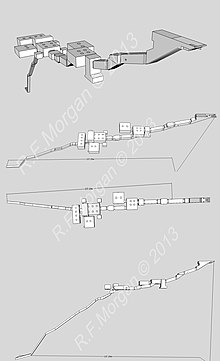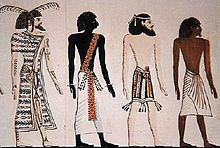KV17
|
KV17 |
|
|---|---|
| place | Valley of the Kings |
| Discovery date | October 16-19, 1817 |
| excavation | Giovanni Battista Belzoni |
| Previous KV16 |
The following KV18 |
The tomb KV17 (also Belzonis tomb , tomb of Apis ) in the southeastern wadi of the Egyptian Valley of the Kings is the resting place of the ancient Egyptian king ( pharaoh ) Seti I from the 19th dynasty . Of the graves identified so far in the necropolis , it is considered to be the longest and deepest grave and, both in construction and in its decoration with artistic wall paintings and extensive religious hieroglyphic texts, as a prime example of the highly developed ancient Egyptian culture.
Architecture and equipment
The vaulted walkways have a straight and south-westerly axis and, with seven corridors and ten chambers, measure a total length of 137 meters that has so far been exposed. The tomb of Seti I reflects the highly developed ancient Egyptian art of tombs through an extremely complex and almost complete design with wall paintings and religious texts, which set standards for all subsequent tombs built in the New Kingdom in the Valley of the Kings.
The grave walls depict for the first time in detail the mythological dramaturgy of the king's journey into the afterlife on a painted and raised relief . Below is the litany of Re , in which the pharaoh unites with the sun god, in the entrance corridor and in the subsequent stairwell as the opening scene . The grave also contains the Book of the Dead , the Book of the Portals , scenes from the Amduat Book as well as the Book of the Divine Cow and the opening ceremony of the mouth . The chambers, corridors and stairs described below are numbered from A to K with increasing depth.
Column hall F
The first columned hall F is an almost rectangular chamber, the ceiling of which is decorated with stars and supported by four columns along the grave axis. All wall surfaces are fully painted. The wall painting on the left south-east wall contains the fifth hour of the port book in three horizontal registers . According to the conventional representation, the various 12 deities, which are assigned to the 12 hours of the night, are led along a string, which symbolically divides the time. In the middle register, the serpent-shaped god of darkness Apophis is pushed back and the various Ba of the deceased king are shown. The fifth hour ends in the lower register with a typical scene in which Horus watches over four people of different skin colors, representing the four groups of people known at the time, Egyptians, Libyans , Nubians and Asians, and assuring them that they will survive in the afterlife.
Burial chamber J
In the burial chamber , Belzoni came across an undecorated approximately 1 meter wide, 1.50 meter high and at least 120 meter long sloping shaft below the sarcophagus of Seti I, which is now in Sir John Soane ’s Museum in London , which is still today has not been fully excavated. In 2001 the Egyptian Antiquities Administration approved a geophysical survey of this Corridor K at the bottom of the tomb, but no scientific evidence has been published since then.
Historical development of the grave
The grave in ancient times
The British Egyptologist Alan Gardiner dated the construction of the tomb to a period between 1308 and 1294 BC. After the burial of Seti I, KV17 served as a temporary hiding place for numerous other royal mummies, including those of the pharaohs Ramses I and Ramses II , before they were successively reburied after TT320 .
The grave in modern times
Giovanni Battista Belzoni discovered the grave after the uncovering of KV16 , when he had another dig on October 16, 1817, in the immediate vicinity at the foot of a steep hill. After the workers actually came across a hewn rock the following evening, Belzoni was able to manage on 18./19. enter the tomb and then carry out the first conservation and excavation work, during which he penetrated up to 90 meters into the shaft leading from the burial chamber . Belzoni also made evaluations of the hieroglyphic texts and wall paintings with the help of wax prints and watercolor drawings . During his work, Belzoni and his wife moved into the grave at short notice as accommodation.
James Burton continued the conservation measures in 1825 by building small walls at the grave entrance to protect against water ingress and cleared the well shaft from the debris from previous excavations. Between 1844 and 1845, the German Egyptologist Richard Lepsius carried out an extensive survey of the grave for the first time, which he recorded in floor plans. Lepsius also paid great attention to the vaulted astronomical star ceiling in the burial chamber. The British Egyptologist Howard Carter then carried out static repairs from 1902 to 1904 by replacing the door posts removed by Champollion and Rosellini and brought to the Louvre in Paris and Florence , respectively , with masonry. He also provided the entrance to shaft K with masonry and built a stone staircase at its upper end. Unfortunately, the wall paintings were damaged by the numerous wax copies and by candle smoke and humid breathing air and have faded or disappeared compared to the state of discovery. Assuming that Shaft K leads to the actual burial chamber of Seti I, which is filled with valuable grave goods, Sheikh Ali Abdul Rassul expanded the corridor by around 30 meters in the 1950s, but without encountering the chamber he had hoped for.
The Theban Mapping Project published a completed floor plan of the tomb, including Shaft K, in 1979, the purpose and destination of which remained unexplained, arguing that the extreme depth of the steeply sloping corridor contradicted the theory that the tomb of Seti I was with an underground structure to the east connected to the grave. The Swiss archaeologist and Egyptologist Gerhardt Haeny takes the view that the passage feeds water and thus fulfills the same symbolic function as it is in the cenotaph of Seti I in Abydos , where, according to ancient Egyptian beliefs, the burial place has an underground connection with the primordial flood Well as Symbol of creation and rebirth.
Digital reconstruction for preservation
The Theban Necropolis Preservation Initiative (TNPI), a cooperation of the Factum Foundation and the University of Basel, is trying to digitally preserve ancient sites. In the exhibition "Scanning Set. The rebirth of a pharaoh's grave " from October 29, 2017 - May 6, 2018 in the Antikenmuseum Basel, a scale facsimile of the two most magnificent burial chambers and the sarcophagus Set I can be seen as part of a scientific replica . The facsimile reconstruction was created using modern reproduction technology to save threatened cultural heritage: the objects and rooms were 3D scanned in 2016 using laser scanners, Canon EOS digital cameras and specially developed software. The re-materialization was carried out by a combination of CNS milling of plastic sheets for rough modeling and coating with thin, flexible relief foils from a relief printing process developed by the EIGER project , in which an Océ 3D printer is used. A digital restoration of missing fragments also takes place .
See also
literature
- Erik Hornung : The grave of Sethos I. Artemis & Winkler, Düsseldorf 1999, ISBN 3-538-07092-X .
- Erik Hornung: Valley of the Kings. Weltbild, Augsburg 1996, ISBN 3-89350-741-8 .
- Erik Hornung: The Valley of the Kings. Beck, Munich 2002, ISBN 3-406-47995-2 .
- Jadwiga Lipińska : The Mysterious Tunnel. In: Christopher Eyre, Anthony Leahy, Lisa Montagno Leahy (editors): The Unbroken Reed: Studies in the Culture and Heritage of Ancient Egypt in Honor of AF Shore. Egyptian Exploration Society: Occasional Publications 11, London 1994, pp. 193-194.
- Nicholas Reeves : Valley of the Kings: The Decline of a Royal Necropolis. Studies in Egyptology. Kegan Paul International, London 1990, pp. 92-94.
- Nicholas Reeves, Richard H. Wilkinson : The Valley of the Kings. Mysterious realm of the dead of the pharaohs. Bechtermünz, Augsburg 2000, ISBN 3-8289-0739-3 .
- Alberto Siliotti: Valley of the Kings: the most famous necropolis in the world. Müller, Cologne 2001, ISBN 88-8095-602-7 .
- Kent R. Weeks , Araldo de Luca: In the Valley of the Kings - Of funerary art and the cult of the dead of the Egyptian rulers. Weltbild, Augsburg 2001, ISBN 3-8289-0586-2 .
Web links
- Theban Mapping Project : KV17 (English)
- The Tomb of Seti I (excerpt from Belzoni's Narrative of the Operations and Recent Discoveries Within the Pyramids, Temples, Tombs and Excavations in Egypt and Nubia from 1820, in which he reports on the discovery of KV17; English)
Individual evidence
- ↑ http://www.factumfoundation.org/ind/46/The-Theban-Necropolis-Preservation-Initiative
- ↑ http://www.antikenmuseumbasel.ch/de/ausstellungen.html
- ↑ https://issuu.com/antikenmuseumbasel/docs/antike_broschuere-sethos_inhalt2/140
- ↑ https://issuu.com/antikenmuseumbasel/docs/antike_broschuere-sethos_inhalt2/164
Coordinates: 25 ° 44 ′ 24 ″ N , 32 ° 36 ′ 7 ″ E





